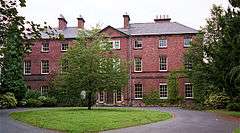Tapton House

Tapton House, in Tapton, Chesterfield, Derbyshire, England, was once the home of engineer George Stephenson, who built the first public railway line in the world to use steam locomotives. In its time Tapton has been a gentleman's residence, a ladies' boarding school and a co-educational school.[1]
Tapton House grounds are now open for free use by the general public of Chesterfield to walk around and visit the Tapton Gardens. The grounds are also shared with the Tapton Park Innovation Centre. The House itself is now the High Education Campus of Chesterfield College, and is a Grade II* listed building.[2]
History
Tapton House was constructed in the late 18th century by the Wilkinson family of bankers, who also helped fund the construction of the Chesterfield Canal. English mechanical engineer George Stephenson, builder of the first public railway line in the world to use steam locomotives, leased the house from the family from 1832 until his death in 1848.
The house then was bought by Charles Markham, Director of Staveley Coal and Iron Company and three times Mayor of the town, in 1871 and became the family home until 1925, when he gave the 200 acres (0.81 km2) of parkland to the Borough of Chesterfield. The borough turned the house into a school and in 1931, the first pupils passed through its doors as Tapton House Central Selective School. After the Second World War it became a co-educational grammar school, Tapton House Grammar School. The school continued to teach students until 1993 when it closed. After refurbishment in September 1994 it became a College of Further and Higher Education for the people of Chesterfield and the surrounding area, known as The Tapton House Campus of Chesterfield College.
George Stephenson (1781–1848)
George Stephenson, born in 1781, had already become a nationally known figure before he came to Chesterfield in the 1830s to construct the North Midland Railway which stretches 72 miles (116 km) from Derby to Leeds. His son Robert designed the historically important steam locomotive named Rocket for the Rainhill Trials at Liverpool in 1829.[3]
He became so attached to Chesterfield that he spent the rest of his life in the area. Tapton House was his home for the last ten years of his life, until his death in August 1848 at the age of 67. Stephenson was buried in the Holy Trinity Church on Newbold Road, Chesterfield.
Tapton Park Innovation Centre

The centre developed out of a partnership between Chesterfield Borough Council, North Derbyshire Chamber of Commerce and North Derbyshire Training and Enterprise Council.[4] As well as funding from the partners the scheme was supported by the Single Regeneration Budget and European Union.
The futuristic building reflects the forwards thinking of George Stephenson. It is designed to provide modern accommodation to stimulate innovation and nurture growth amongst technology- and knowledge-based business. The centre has 39 rooms, 10 "rent-a-desks" and, following its opening in spring 1997, accommodates more than 40 companies.
Peace Gardens
Opened in August 1947 by Mayor, Councillor Miss Florence Robinson, the gardens were constructed by the Parks Department Under the supervision of Mr J. E. Tindale, Park Superintendent.
Castle Hill
This is an earth mound believed to be the site of a motte-and-bailey castle. The earth mound or motte would have been the site of the shell keep, being several buildings surrounded by heavy wooden palisade. Around 600 castles of this type are recorded and were built between 1000 and 1200 AD. The castle was incorporated within the grounds of Tapton House in the late 17th century.
References
- ↑ Tapton School website
- ↑ Historic England. "Tapton House (Grade II*) (1088335)". National Heritage List for England. Retrieved 10 September 2013.
- ↑ Haworth, Victoria (2004). Robert Stephenson: The Making of a Prodigy. Newcastle-upon-Tyne: The Rocket Press. ISBN 0-9535162-1-0.
- ↑ Official Tapton Park Innovation Centre's website
External links
Coordinates: 53°14′42″N 1°24′50″W / 53.2450°N 1.4138°W